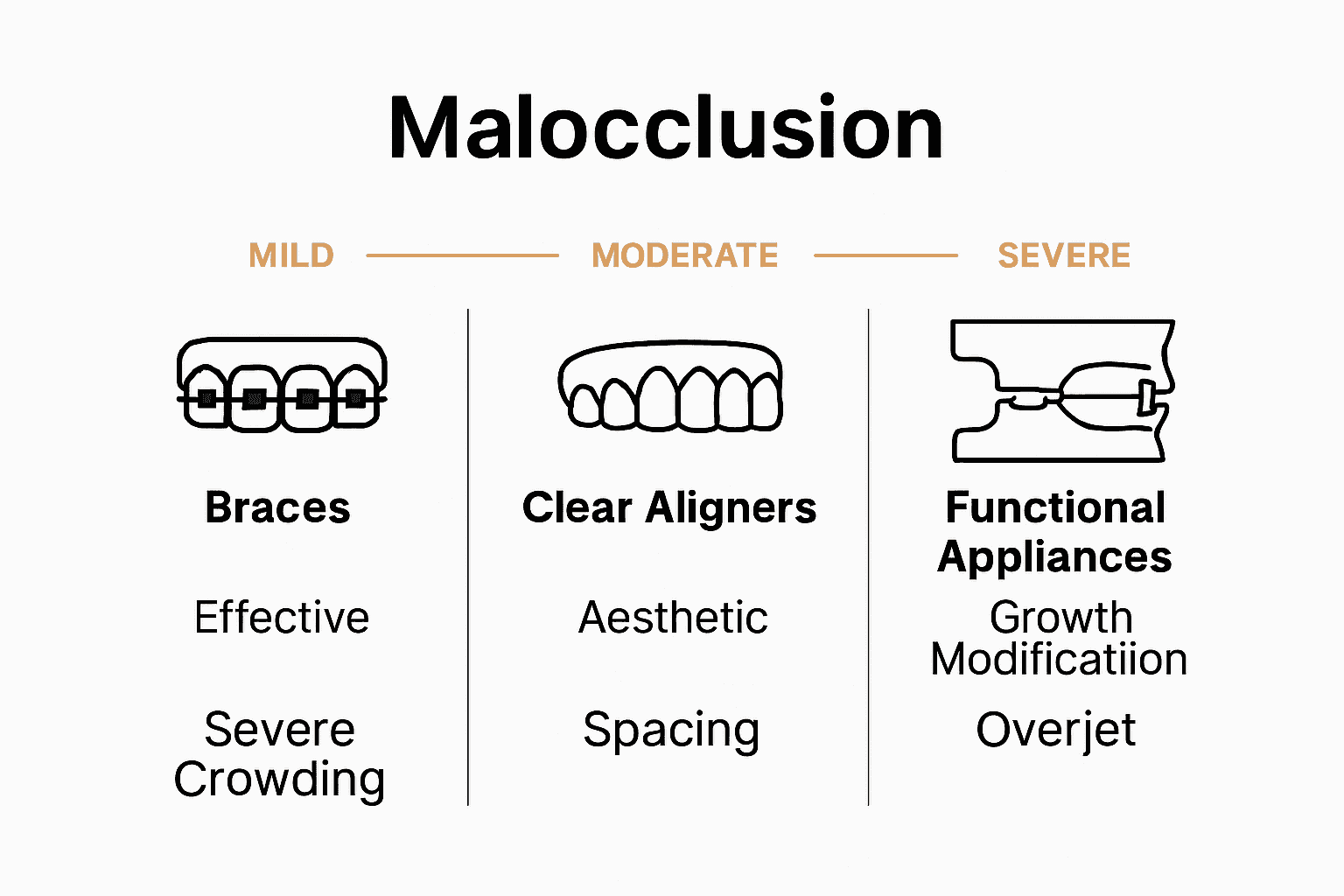Malocclusion Explained: Types, Causes, and Treatment Options
October 20, 2025
Malocclusion Explained: Types, Causes, and Treatment Options
Did you know that malocclusion affects up to 30 percent of orthodontic patients? This common dental issue impacts far more than just how your smile looks. If your teeth are not properly aligned, you could face problems with chewing, speech, and even your long-term dental health. Learning about malocclusion helps you spot warning signs early, so you can protect both the appearance and function of your teeth for years to come.
Key Takeaways
| Point | Details |
|---|---|
| Understanding Malocclusion | Malocclusion affects dental alignment and function, leading to various oral health issues if untreated. |
| Classification of Types | Malocclusion is categorized into three classes: Class I (most common), Class II (moderate alignment issues), and Class III (severe misalignment). |
| Causes and Risk Factors | Genetic, environmental, and behavioral factors contribute to malocclusion, emphasizing the importance of early intervention. |
| Treatment Options | Orthodontic treatment varies and includes braces, aligners, and surgical options, tailored to individual needs and severity. |
Table of Contents
- What Is Malocclusion And Why It Matters
- Common Types Of Dental Malocclusion
- Causes And Risk Factors For Malocclusion
- Recognizing Symptoms And Potential Complications
- Treatment Options And Expected Outcomes
- Comparing Braces, Aligners, And Alternatives
What Is Malocclusion and Why It Matters
Malocclusion is more than just a complex dental term—it’s a critical condition that impacts how your teeth align and function. According to MedlinePlus, malocclusion occurs when teeth are not properly positioned, meaning your upper teeth do not correctly overlap the lower teeth. This misalignment can range from mild cosmetic concerns to significant oral health challenges that affect bite efficiency and long-term dental wellness.
At its core, malocclusion represents a deviation from the ideal dental arrangement. As defined by dental experts, it involves an incorrect relationship between the upper and lower teeth when the jaws close. Research indicates that between 17% to 30% of orthodontic patients experience some form of malocclusion, making it a surprisingly common dental condition. The implications extend far beyond aesthetics—misaligned teeth can create challenges in speaking, eating, and maintaining proper oral hygiene.
Why does malocclusion matter? The consequences are more profound than many realize. Untreated malocclusion can lead to:
- Increased risk of tooth decay
- Potential jaw joint problems
- Uneven tooth wear
- Challenges with proper chewing and digestion
- Self-confidence issues related to dental appearance
Understanding malocclusion is the first step toward addressing potential dental alignment issues. Professional orthodontic assessment can help diagnose the specific type and severity of misalignment, paving the way for targeted treatments that restore both function and confidence.
Common Types of Dental Malocclusion
Dental malocclusion isn’t a one-size-fits-all condition. According to the Dewey–Anderson classification, malocclusion is categorized into distinct types that help orthodontists diagnose and treat specific dental alignment issues. These classifications provide a roadmap for understanding how teeth can deviate from ideal positioning.
Class I Malocclusion is the most prevalent type, affecting approximately 35–94% of patients globally. This category includes several common dental misalignments such as crowding, spacing, crossbites, and open bites. In Class I, the molars are correctly positioned, but other teeth show variations in alignment. Typical characteristics include slight overcrowding of teeth or minor protrusions that don’t significantly impact overall bite function.
Class II Malocclusion is characterized by a more pronounced misalignment. This type often involves an overjet (horizontal gap between upper and lower teeth) and a deep overbite, frequently presenting with a V-shaped upper dental arch. Research indicates this type affects roughly 4–45% of patients and can create more complex orthodontic challenges.
Class III Malocclusion, the least common type, involves an underbite where the lower jaw protrudes forward. Affecting approximately 1–19% of patients, this classification represents the most significant deviation from standard dental alignment. Individuals with Class III malocclusion may experience more substantial functional and aesthetic challenges that often require comprehensive orthodontic intervention.
Understanding these classifications helps patients and orthodontists develop targeted treatment strategies. While each type presents unique challenges, modern orthodontic techniques offer effective solutions for improving dental alignment and overall oral health.

Here’s a summary of the main types of dental malocclusion:
| Type | Key Features | Prevalence |
|---|---|---|
| Class I Malocclusion | Normal molar relation Crowding Spacing |
35–94% (most common) |
| Class II Malocclusion | Overjet Deep bite V-shaped upper arch |
4–45% |
| Class III Malocclusion | Underbite Lower jaw protrudes |
1–19% (least common) |
Causes and Risk Factors for Malocclusion
Malocclusion emerges from a complex interplay of genetic, environmental, and behavioral factors. According to Wikipedia’s comprehensive overview, the causes are multifactorial, spanning skeletal, muscular, and dental domains. Understanding these diverse influences helps explain why some individuals are more prone to dental misalignment than others.
Genetic factors play a significant role in determining jaw size, shape, and tooth positioning. Skeletal influences can predispose individuals to malocclusion through inherited characteristics that affect facial structure. Simultaneously, environmental factors like childhood oral habits dramatically impact dental development. Behaviors such as prolonged thumb-sucking, pacifier use, and tongue thrusting can substantially alter tooth alignment and jaw growth.
A groundbreaking 2023 epidemiological study revealed additional nuanced risk factors for malocclusion. Key findings include:
- Improper oral habits like tongue thrusting
- Presence of dental caries in primary teeth
- Mandibular prognathism (protrusion of the lower jaw)
- Reduced duration or absence of breastfeeding
- Complications during childbirth
Interestingly, some factors can actually protect against malocclusion. Extended breastfeeding and certain childbirth methods appear to positively influence dental alignment. This underscores the intricate relationship between early developmental experiences and long-term oral health. While some risk factors are unavoidable, understanding these influences empowers parents and individuals to make informed decisions about dental care and early intervention strategies.
Recognizing Symptoms and Potential Complications
Malocclusion manifests through a range of symptoms that extend far beyond simple cosmetic concerns. Wikipedia’s medical overview highlights several key indicators that individuals and parents should watch for, including challenges with tooth alignment, oral function, and overall dental health.
Physical symptoms often provide the first clues to potential malocclusion. These may include visible misalignment of teeth, difficulty chewing or biting, and unexpected speech patterns like lisps. According to comprehensive research, untreated malocclusion can trigger a cascade of more serious complications that impact both physical and emotional well-being.
The potential complications of untreated malocclusion are surprisingly extensive:
-
Oral Health Risks
- Increased tooth decay risk
- Premature tooth wear
- Challenges maintaining proper oral hygiene
- Higher susceptibility to periodontal disease
-
Functional Impairments
- Chewing and swallowing difficulties
- Speech impediments
- Temporomandibular joint disorders
- Breathing issues including mouth-breathing
-
Psychological Impact
- Reduced self-esteem
- Social interaction challenges
- Potential body image concerns
Beyond the immediate dental implications, untreated malocclusion can lead to surprising secondary effects like chronic headaches, postural problems, and even sleep-related breathing disorders. Early recognition and professional assessment are crucial in preventing these potential long-term complications, emphasizing the importance of regular dental check-ups and proactive orthodontic evaluations.
Treatment Options and Expected Outcomes
Malocclusion treatment is not a one-size-fits-all approach. According to Wikipedia’s comprehensive overview, orthodontic interventions range from conservative methods to more complex surgical approaches, depending on the severity and specific characteristics of an individual’s dental misalignment.
MedlinePlus research emphasizes that treatment effectiveness varies significantly between children and adults. Early intervention in growing patients typically yields faster, more predictable results, with treatment durations ranging from 6 months to 2+ years. The primary goals remain consistent: improving oral hygiene, reducing decay and periodontal disease risk, and enhancing overall dental function and aesthetics.
Key treatment options include:
-
Orthodontic Appliances
- Traditional metal braces
- Ceramic braces
- Clear aligners
- Lingual braces
-
Surgical and Interceptive Interventions
- Tooth extraction
- Palatal expanders
- Growth modification techniques
- Orthognathic surgery (for severe cases)
Expected outcomes depend on multiple factors, including the patient’s age, malocclusion severity, and commitment to treatment. Most patients can anticipate significant improvements in:
- Dental alignment
- Bite functionality
- Oral hygiene capabilities
- Facial symmetry
- Overall self-confidence
While treatment complexity varies, modern orthodontic techniques offer increasingly personalized and efficient solutions. Consultation with a professional orthodontist remains the most critical step in determining the most appropriate treatment strategy for individual needs.
Comparing Braces, Aligners, and Alternatives
Orthodontic treatments have evolved dramatically, offering patients multiple pathways to achieving dental alignment. Each option comes with unique advantages, addressing different types of malocclusion and patient preferences. The landscape of teeth straightening now extends far beyond traditional metal braces.
Traditional braces remain a gold standard for comprehensive dental correction. However, innovative alternatives like clear aligners have gained significant popularity. According to research on specialized orthodontic devices, some advanced options provide targeted solutions for specific malocclusion types. The Herbst appliance, for instance, offers a fascinating approach for correcting mandibular positioning, functioning 24 hours daily and potentially shortening treatment to just 6-8 months.
Key comparison points between treatment options:
-
Traditional Metal Braces
- Most comprehensive correction
- Suitable for complex misalignments
- Visible and less aesthetically pleasing
- Generally most cost-effective
-
Clear Aligners
- Nearly invisible
- Removable for eating and cleaning
- Best for mild to moderate corrections
- Higher aesthetic appeal
-
Specialized Functional Appliances
- Twin-block appliances for growing patients
- Promotes forward mandibular growth
- Potential 50% skeletal changes
- Psychological benefits
The most appropriate treatment depends on individual factors like age, malocclusion severity, budget, and personal preferences. Consulting with an experienced orthodontist remains the most reliable way to determine the optimal approach for achieving your ideal smile.

Regain Confidence and Comfort with Professional Malocclusion Solutions
Are you frustrated by daily challenges caused by malocclusion, like difficulty chewing, speech concerns, or self-consciousness about your smile? This article has explored how untreated misalignment can lead to health issues and affect your self-esteem. At Glow Orthodontics, we understand that every smile is unique and offer personalized solutions for all types of malocclusion, including clear aligners and traditional braces.

Take the first step towards a healthier and more confident you by connecting with our friendly team. See how easy it is to schedule a consultation and discover a treatment plan tailored to your needs at Glow Orthodontics. Your glowing smile is within reach—visit our website now to request your appointment and start your journey to lasting results.
Frequently Asked Questions
What is malocclusion?
Malocclusion is a dental condition characterized by improper alignment of the teeth, where the upper teeth do not properly overlap the lower teeth. This misalignment can lead to functional and aesthetic issues.
What are the common types of malocclusion?
The common types of malocclusion include Class I Malocclusion, which features normal molar relationships with issues like crowding or spacing; Class II Malocclusion, marked by an overjet and deep overbite; and Class III Malocclusion, characterized by an underbite.
What causes malocclusion?
Malocclusion can be caused by a combination of genetic and environmental factors. Factors such as jaw size and shape, childhood oral habits (like thumb-sucking), and even complications during childbirth can influence dental alignment.
What treatment options are available for malocclusion?
Treatment options for malocclusion include orthodontic appliances like traditional metal braces, ceramic braces, and clear aligners, as well as surgical interventions for more severe cases. Early assessment and intervention generally lead to better outcomes.